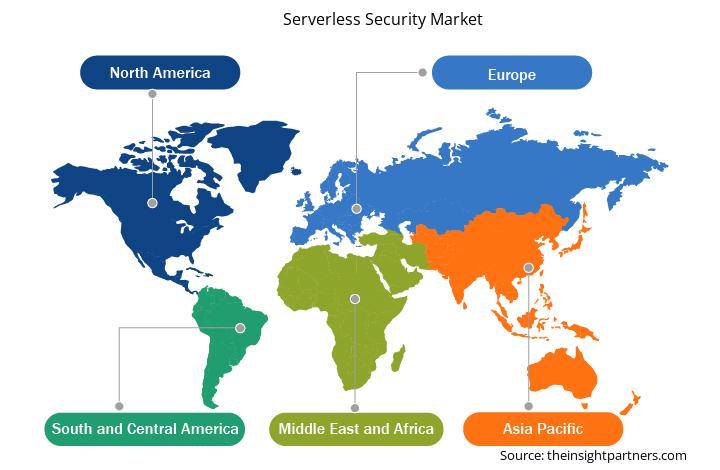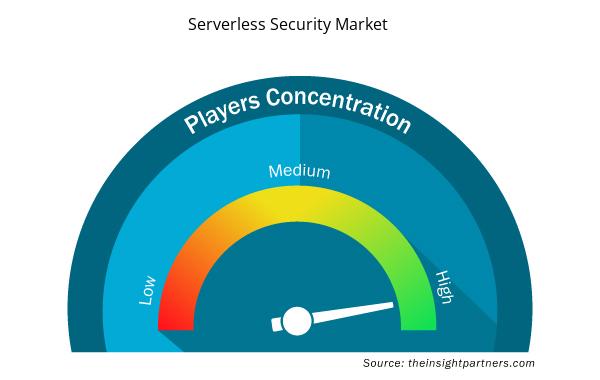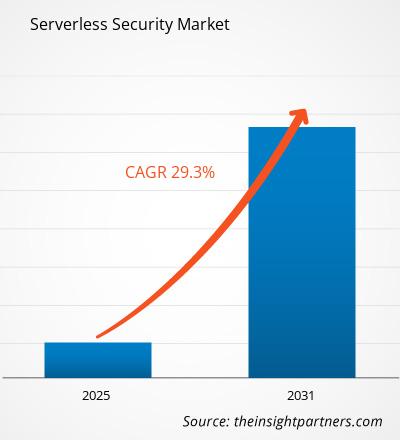Se espera que el mercado de seguridad sin servidor registre una CAGR del 29,3 % entre 2025 y 2031, y que el tamaño del mercado se expanda de US$ XX millones en 2024 a US$ XX millones en 2031.
El informe está segmentado por modelo de servicio (FAAS, BAAS), tipo de seguridad (seguridad de datos, seguridad de red, seguridad de aplicaciones, otros), implementación (nube, local) y uso final (BFSI, salud, comercio minorista y electrónico, TI y telecomunicaciones, gobierno y sector público, manufactura, otros). El análisis global se desglosa a nivel regional y por países principales. El informe ofrece el valor en USD para el análisis y los segmentos mencionados.
Propósito del Informe
El informe "Mercado de Seguridad Sin Servidor" de The Insight Partners busca describir el panorama actual y el crecimiento futuro, los principales factores impulsores, los desafíos y las oportunidades. Esto proporcionará información a diversas partes interesadas del negocio, como:
- Proveedores/Fabricantes de Tecnología: Para comprender la dinámica cambiante del mercado y conocer las oportunidades potenciales de crecimiento, lo que les permitirá tomar decisiones estratégicas informadas.
- Inversores: Realizar un análisis exhaustivo de tendencias respecto a la tasa de crecimiento del mercado, las proyecciones financieras del mercado y las oportunidades que existen en toda la cadena de valor.
- Organismos reguladores: Regular las políticas y las actividades policiales en el mercado con el objetivo de minimizar el abuso, preservar la confianza de los inversores y defender la integridad y estabilidad del mercado.
Segmentación del mercado de seguridad sin servidor
Modelo de servicio
- FAAS
- BAAS
Tipo de seguridad
- Seguridad de datos
- Seguridad de la red
- Seguridad de las aplicaciones
Despliegue
- Nube
- En las instalaciones
Uso final
- BFSI
- Cuidado de la salud
- Comercio minorista y comercio electrónico
- TI y Telecomunicaciones
- Gobierno y sector público
- Fabricación
Personalice este informe según sus necesidades
Recibirá personalización de cualquier informe, sin cargo, incluidas partes de este informe o análisis a nivel de país, paquete de datos de Excel, así como también grandes ofertas y descuentos para empresas emergentes y universidades.
Mercado de seguridad sin servidor: perspectivas estratégicas

- Obtenga las principales tendencias clave del mercado de este informe.Esta muestra GRATUITA incluirá análisis de datos, desde tendencias del mercado hasta estimaciones y pronósticos.
Factores que impulsan el crecimiento del mercado de seguridad sin servidor
- Aumento en la adopción de la informática sin servidor: A medida que las empresas migran cada vez más a arquitecturas sin servidor para reducir la complejidad de su infraestructura, crece la demanda de soluciones de seguridad sin servidor. Los entornos sin servidor ofrecen escalabilidad y flexibilidad, pero también plantean nuevos desafíos de seguridad. Las organizaciones necesitan herramientas de seguridad especializadas para proteger sus aplicaciones sin servidor de vulnerabilidades, accesos no autorizados y filtraciones de datos, lo que impulsa el crecimiento del mercado de la seguridad sin servidor.
- Aumento de las amenazas a la ciberseguridad: El aumento de los ciberataques, incluyendo filtraciones de datos, ransomware y malware, ha intensificado la atención a la ciberseguridad. Los entornos sin servidor, si bien ofrecen numerosas ventajas, pueden presentar vulnerabilidades únicas, como la exposición de las API y la falta de visibilidad de los registros de seguridad. Esto ha acelerado la demanda de herramientas avanzadas de seguridad sin servidor diseñadas para abordar estos riesgos específicos, impulsando el crecimiento del mercado.
- Cumplimiento normativo y protección de datos: Los estrictos marcos regulatorios, como el RGPD y la CCPA, han convertido la protección de datos en una preocupación crucial para las organizaciones. Los entornos sin servidor requieren mecanismos de seguridad robustos para garantizar el cumplimiento de estas normativas. La necesidad de monitorización en tiempo real, detección de amenazas y cifrado de datos en arquitecturas sin servidor ha impulsado la demanda de soluciones de seguridad adaptadas a estos entornos, impulsando el mercado.
Tendencias futuras del mercado de seguridad sin servidor
- Integración de IA y aprendizaje automático: La inteligencia artificial (IA) y el aprendizaje automático (ML) se integran cada vez más en las soluciones de seguridad sin servidor para proporcionar detección y respuesta automatizadas ante amenazas. Estas tecnologías ayudan a identificar anomalías y posibles vulnerabilidades en tiempo real, mejorando la eficacia de las medidas de seguridad. A medida que la IA y el ML siguen evolucionando, ofrecen funciones de seguridad avanzadas y proactivas que impulsan el crecimiento del mercado de la seguridad sin servidor.
- Enfoque en modelos de seguridad de confianza cero: La creciente adopción del modelo de seguridad de confianza cero, que asume que las amenazas son internas y externas, está influyendo en el mercado de la seguridad sin servidor. Los entornos sin servidor requieren una validación constante de usuarios y sistemas para garantizar un acceso seguro. A medida que las organizaciones adoptan los principios de confianza cero, las soluciones de seguridad sin servidor se diseñan cada vez más para admitir el control de acceso granular y la monitorización continua, lo que impulsa la demanda en el mercado.
Oportunidades del mercado de seguridad sin servidor
- Expansión a entornos de nube híbrida: A medida que las empresas avanzan hacia arquitecturas de nube híbrida, donde la computación sin servidor se integra con los sistemas locales tradicionales, crece la necesidad de soluciones de seguridad que protejan tanto los entornos en la nube como los locales. Esta tendencia representa una gran oportunidad para que los proveedores de seguridad sin servidor ofrezcan soluciones de seguridad unificadas y multiplataforma que se adapten al panorama de la nube híbrida.
- Creciente demanda de las pymes: Las pequeñas y medianas empresas (pymes) adoptan cada vez más arquitecturas sin servidor debido a su rentabilidad y escalabilidad. Dado que las pymes suelen contar con recursos limitados para gestionar infraestructuras de seguridad complejas, existe una creciente oportunidad para que los proveedores de seguridad sin servidor ofrezcan soluciones asequibles y fáciles de implementar que satisfagan las necesidades específicas de las organizaciones más pequeñas, ampliando así su alcance de mercado.
Perspectivas regionales del mercado de seguridad sin servidor
Los analistas de Insight Partners han explicado detalladamente las tendencias y los factores regionales que influyen en el mercado de seguridad sin servidor durante el período de pronóstico. Esta sección también analiza los segmentos y la geografía del mercado de seguridad sin servidor en Norteamérica, Europa, Asia Pacífico, Oriente Medio y África, y Sudamérica y Centroamérica.

- Obtenga datos regionales específicos para el mercado de seguridad sin servidor
Alcance del informe del mercado de seguridad sin servidor
| Atributo del informe | Detalles |
|---|---|
| Tamaño del mercado en 2024 | US$ XX millones |
| Tamaño del mercado en 2031 | US$ XX millones |
| CAGR global (2025-2031) | 29,3% |
| Datos históricos | 2021-2023 |
| Período de pronóstico | 2025-2031 |
| Segmentos cubiertos | Por modelo de servicio
|
| Regiones y países cubiertos | América del norte
|
| Líderes del mercado y perfiles de empresas clave |
|
Densidad de actores del mercado de seguridad sin servidor: comprensión de su impacto en la dinámica empresarial
El mercado de seguridad sin servidor está creciendo rápidamente, impulsado por la creciente demanda de los usuarios finales debido a factores como la evolución de las preferencias de los consumidores, los avances tecnológicos y una mayor comprensión de los beneficios del producto. A medida que aumenta la demanda, las empresas amplían su oferta, innovan para satisfacer las necesidades de los consumidores y aprovechan las tendencias emergentes, lo que impulsa aún más el crecimiento del mercado.
La densidad de actores del mercado se refiere a la distribución de empresas o compañías que operan en un mercado o sector en particular. Indica cuántos competidores (actores del mercado) hay en un mercado determinado en relación con su tamaño o valor total.
Las principales empresas que operan en el mercado de seguridad sin servidor son:
- Seguridad acuática
- Tecnologías de software Check Point
- Perro de datos
- Imperva
- Redes de Palo Alto
- Protego
Descargo de responsabilidad : Las empresas enumeradas anteriormente no están clasificadas en ningún orden particular.

- Obtenga una descripción general de los principales actores clave del mercado de seguridad sin servidor
Puntos clave de venta
- Cobertura integral: el informe cubre exhaustivamente el análisis de productos, servicios, tipos y usuarios finales del mercado de seguridad sin servidor, proporcionando un panorama holístico.
- Análisis de expertos: el informe se compila con base en el conocimiento profundo de expertos y analistas de la industria.
- Información actualizada: El informe asegura relevancia comercial debido a su cobertura de información reciente y tendencias de datos.
- Opciones de personalización: este informe se puede personalizar para satisfacer los requisitos específicos del cliente y adaptarse adecuadamente a las estrategias comerciales.
Por lo tanto, el informe de investigación sobre el mercado de seguridad sin servidor puede ayudar a descifrar y comprender el panorama del sector y sus perspectivas de crecimiento. Si bien existen algunas preocupaciones válidas, las ventajas generales de este informe suelen superar las desventajas.
- Análisis histórico (2 años), año base, pronóstico (7 años) con CAGR
- Análisis PEST y FODA
- Tamaño del mercado Valor/volumen: global, regional, nacional
- Industria y panorama competitivo
- Conjunto de datos de Excel



Report Coverage
Revenue forecast, Company Analysis, Industry landscape, Growth factors, and Trends

Segment Covered
This text is related
to segments covered.

Regional Scope
North America, Europe, Asia Pacific, Middle East & Africa, South & Central America

Country Scope
This text is related
to country scope.
Preguntas frecuentes
Some of the customization options available based on the request are an additional 3–5 company profiles and country-specific analysis of 3–5 countries of your choice. Customizations are to be requested/discussed before making final order confirmation# as our team would review the same and check the feasibility
The report can be delivered in PDF/PPT format; we can also share excel dataset based on the request
Focus on zero-trust security models to play a significant role in the global serverless security market in the coming years
Rise in serverless computing adoption and regulatory compliance and data protection fueling market demand are the major factors driving the serverless security market
The global serverless security market is expected to grow at a CAGR of 29.3% during the forecast period 2024 - 2031
Trends and growth analysis reports related to Technology, Media and Telecommunications : READ MORE..
The Insight Partners performs research in 4 major stages: Data Collection & Secondary Research, Primary Research, Data Analysis and Data Triangulation & Final Review.
- Data Collection and Secondary Research:
As a market research and consulting firm operating from a decade, we have published and advised several client across the globe. First step for any study will start with an assessment of currently available data and insights from existing reports. Further, historical and current market information is collected from Investor Presentations, Annual Reports, SEC Filings, etc., and other information related to company’s performance and market positioning are gathered from Paid Databases (Factiva, Hoovers, and Reuters) and various other publications available in public domain.
Several associations trade associates, technical forums, institutes, societies and organization are accessed to gain technical as well as market related insights through their publications such as research papers, blogs and press releases related to the studies are referred to get cues about the market. Further, white papers, journals, magazines, and other news articles published in last 3 years are scrutinized and analyzed to understand the current market trends.
- Primary Research:
The primarily interview analysis comprise of data obtained from industry participants interview and answers to survey questions gathered by in-house primary team.
For primary research, interviews are conducted with industry experts/CEOs/Marketing Managers/VPs/Subject Matter Experts from both demand and supply side to get a 360-degree view of the market. The primary team conducts several interviews based on the complexity of the markets to understand the various market trends and dynamics which makes research more credible and precise.
A typical research interview fulfils the following functions:
- Provides first-hand information on the market size, market trends, growth trends, competitive landscape, and outlook
- Validates and strengthens in-house secondary research findings
- Develops the analysis team’s expertise and market understanding
Primary research involves email interactions and telephone interviews for each market, category, segment, and sub-segment across geographies. The participants who typically take part in such a process include, but are not limited to:
- Industry participants: VPs, business development managers, market intelligence managers and national sales managers
- Outside experts: Valuation experts, research analysts and key opinion leaders specializing in the electronics and semiconductor industry.
Below is the breakup of our primary respondents by company, designation, and region:

Once we receive the confirmation from primary research sources or primary respondents, we finalize the base year market estimation and forecast the data as per the macroeconomic and microeconomic factors assessed during data collection.
- Data Analysis:
Once data is validated through both secondary as well as primary respondents, we finalize the market estimations by hypothesis formulation and factor analysis at regional and country level.
- Macro-Economic Factor Analysis:
We analyse macroeconomic indicators such the gross domestic product (GDP), increase in the demand for goods and services across industries, technological advancement, regional economic growth, governmental policies, the influence of COVID-19, PEST analysis, and other aspects. This analysis aids in setting benchmarks for various nations/regions and approximating market splits. Additionally, the general trend of the aforementioned components aid in determining the market's development possibilities.
- Country Level Data:
Various factors that are especially aligned to the country are taken into account to determine the market size for a certain area and country, including the presence of vendors, such as headquarters and offices, the country's GDP, demand patterns, and industry growth. To comprehend the market dynamics for the nation, a number of growth variables, inhibitors, application areas, and current market trends are researched. The aforementioned elements aid in determining the country's overall market's growth potential.
- Company Profile:
The “Table of Contents” is formulated by listing and analyzing more than 25 - 30 companies operating in the market ecosystem across geographies. However, we profile only 10 companies as a standard practice in our syndicate reports. These 10 companies comprise leading, emerging, and regional players. Nonetheless, our analysis is not restricted to the 10 listed companies, we also analyze other companies present in the market to develop a holistic view and understand the prevailing trends. The “Company Profiles” section in the report covers key facts, business description, products & services, financial information, SWOT analysis, and key developments. The financial information presented is extracted from the annual reports and official documents of the publicly listed companies. Upon collecting the information for the sections of respective companies, we verify them via various primary sources and then compile the data in respective company profiles. The company level information helps us in deriving the base number as well as in forecasting the market size.
- Developing Base Number:
Aggregation of sales statistics (2020-2022) and macro-economic factor, and other secondary and primary research insights are utilized to arrive at base number and related market shares for 2022. The data gaps are identified in this step and relevant market data is analyzed, collected from paid primary interviews or databases. On finalizing the base year market size, forecasts are developed on the basis of macro-economic, industry and market growth factors and company level analysis.
- Data Triangulation and Final Review:
The market findings and base year market size calculations are validated from supply as well as demand side. Demand side validations are based on macro-economic factor analysis and benchmarks for respective regions and countries. In case of supply side validations, revenues of major companies are estimated (in case not available) based on industry benchmark, approximate number of employees, product portfolio, and primary interviews revenues are gathered. Further revenue from target product/service segment is assessed to avoid overshooting of market statistics. In case of heavy deviations between supply and demand side values, all thes steps are repeated to achieve synchronization.
We follow an iterative model, wherein we share our research findings with Subject Matter Experts (SME’s) and Key Opinion Leaders (KOLs) until consensus view of the market is not formulated – this model negates any drastic deviation in the opinions of experts. Only validated and universally acceptable research findings are quoted in our reports.
We have important check points that we use to validate our research findings – which we call – data triangulation, where we validate the information, we generate from secondary sources with primary interviews and then we re-validate with our internal data bases and Subject matter experts. This comprehensive model enables us to deliver high quality, reliable data in shortest possible time.

 Obtenga una muestra gratuita de este informe
Obtenga una muestra gratuita de este informe